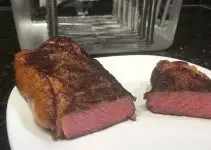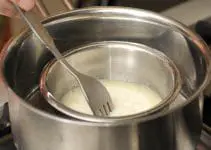Table of Contents
Choosing the right cooking oil to sear your meat with after sous vide is essential because oils turn rancid upon reaching their smoke point. This negatively affects your health and the taste of your food.
In this post, we’ll cover the best high smoke point oils for searing your meats while looking at ones you should stay away from.
7 Best Oils For Sous Vide Searing
Consider these seven oils when searing meats since they have a high smoke point and won’t impact the flavor of your steak.
- Avocado oil
- Extra light olive oil
- Coconut oil
- Beef tallow or lard
- Ghee
- Peanut oil
- Extra virgin olive oil
Avocado oil is the best oil to sear your meats with as it has a smoke point of 520 degrees Fahrenheit. The average steak searing temperature is 350 degrees Fahrenheit, so this oil won’t start smoking and burning.
Several studies show that avocado oil protects your heart from disease. The high-fat content also helps you absorb nutrients like vitamins A, D, E, and K.
The only drawback is that it has a slight avocado taste, and this can affect the flavor of your steak. But you can counteract this by adding butter before your steak is finished searing.
The buttery taste overwhelms the avocado oil, leading to a tasty steak.
Pros
- It has the highest smoke point of all oils
- It doesn’t solidify at room temperature like coconut oil
- The antioxidants boost heart health
Cons
- The avocado taste can affect your steak’s flavor
- It’s an impractical option if you’re allergic to avocados
Extra light olive oil is similar to extra virgin olive oil, but the main difference is its higher smoke point. This makes it a handy option for high-heat searing.
If you don’t like the taste of avocado oil, you’ll be happy to know that this type of olive oil has a neutral taste and lighter color, so you can barely taste it on your steak.
Clocking in at 470 degrees Fahrenheit, extra light olive oil will remain stable under high heat.
However, it’s crucial to get 100 percent extra light olive oil. Many companies add other oils, like canola oil, as it’s cheaper. But this reduces the smoke point and negatively affects your health.
Pros
- It has a higher smoke point than extra virgin olive oil
- There are studies showing health benefits like reduced inflammation and cholesterol
- The taste isn’t as harsh as extra virgin olive oil
Cons
- Finding top-quality extra light olive oil is challenging
- Excess consumption can worsen acne
Coconut oil is another heat-resistant oil that has zero taste. Unlike avocado and extra light olive oil, organic coconut oil is cheap, and you’ll rarely find additives. So it’s an affordable option for anyone sous vide searing on a budget.
The smoke point of coconut oil is 350 degrees Fahrenheit, meaning it isn’t as resistant to heat as avocado oil, and you’ll have to be careful when searing. But if done right, coconut oil won’t give off any flavor and offers the following benefits:
Pros
- The MCTs in coconut oil can lower your risk of Alzehimer’s disease
- It has zero taste
- The high saturated fat content ensures that it’s stable under high heat
Cons
- It solidifies at room temperature
Since beef fat and lard tastes just like steak, it won’t affect your meat flavor, making it a good option for searing after sous vide. Fat has a smoke point of 400 degrees Fahrenheit, so it won’t burn or turn rancid.
Beef tallow is also a tasty alternative to oil if you’re searing vegetables. The animal fat adds a lot of flavor, which takes your pan-seared vegetables to the next level.
Medical papers show that animal fats are nutrient-dense and contain large amounts of vitamins like vitamins A, D, E, K, and B1. This makes beef tallow a tasty choice to increase dietary nutrients.
Pros
- It tastes like animal fat so it won’t affect your steak flavor
- If you’re searing vegetables, it’ll add flavor to it
- You can get it for cheap
Cons
- Most lard sold in grocery stores contain additives
Unlike butter, ghee has a high smoke temperature, so you can use it to sear steaks.
Ghee only starts smoking once it reaches 465 degrees Fahrenheit. And because it tastes like regular butter, it brings a creamy and rich flavor to your steak.
Ghee is also surprisingly stable under high heat, so you won’t have to keep your eye on the temperature all the time. If you have butter at home and want to sear with it, clarify it and turn it into ghee.
Ghee is rich in healthy fats like monounsaturated Omega-3s, which protect your health and reduce unhealthy cholesterol.
Pros
- It has a far higher smoke point than regular butter
- Studies show it can strengthen your immune system and lower inflammation
- It tastes just like butter so it adds a lot of flavor to your meals
Cons
- Consuming too much ghee can result in weight gain
- Ghee is often more expensive than regular butter
Peanut oil offers a smoke point of 450 degrees Fahrenheit, making it as resistant to heat as extra light olive oil and ghee.
However, peanut oil has a slightly nutty flavor that tends to rub off onto your steaks. You’ll prefer this extra flavor if you’re a fan of nuts. But tallow or coconut oil will work better if you’re looking for a neutral oil.
When cooking with peanut oil, it’s essential to limit your consumption since this refined oil is high in omega-6 fatty acids, increasing chronic inflammation.
Pros
- It has the highest monounsaturated fat content of all cooking oils
- Peanut oil has a smoke point of 450 degrees Fahrenheit
- It’s rich in vitamin E which clears your skin and boosts heart health
Cons
- You can’t use peanut oil if you’re allergic to peanuts
- The strong nutty flavor affects the taste of your steak
You could also use refined extra virgin olive oil when searing a steak after sous vide. The smoke point is 374 degrees, slightly higher than the average searing temperature of 350 degrees Fahrenheit.
However, avoid the cold-pressed version of olive oil because these aren’t as stable and tend to burn quickly.
Correctly storing olive oil is essential if you want it to maintain a high smoke point over its lifespan. So keep your bottle in a cool dark place to avoid oxidation.
Pros
- A 2018 study shows that it’s one of the most stable cooking oils
- It contains high amounts of essential nutrients like vitamin E and K
- It reduces your risk of various types of cancers
Cons
- Low-quality brands have a smoke point significantly lower than 374 degrees Fahrenheit
3 Oils To Stay Away From
However, stay away from these options when searing meats:
- Vegetable oils
- Low-quality olive oil
- Butter
Vegetable Oils
Manufacturers put thousands of seeds through a long industrial process to produce vegetable oils like canola oil. During this process, seeds are crushed, and the oil bleached with a chemical solvent, resulting in a tasteless yet harmful end product.
Research shows that vegetable oils have a high omega 3 to 6 ratio, which spikes inflammation in your body, leading to chronic conditions like:
- Alzheimer’s disease
- Heart disease
- Diabetes
Also, canola oil only has a smoke point of 225 degrees Fahrenheit. So when you turn your stove on high, you’ll notice the oil burn and turn rancid.
Low-Quality Olive Oil
Even though olive oil is a good option for steak searing due to its high smoke point and nutritional properties, low-quality olive oil has the opposite effect.
Some cheap cold-pressed olive oils can even have a smoke point as low as 325 degrees Fahrenheit, far lower than what’s needed to sear a steak.
You’ll also notice that low-quality olive oil gives off a sour taste, turning a good steak into an inedible one.
Butter
Butter is tasty and healthy, but its smoke point is around 300 degrees Fahrenheit, making it an impractical option for searing steaks.
This is why butter is super easy to burn. So if you want to avoid this and experience the tastiness of butter with your steak, toss in a few cubes just before removing your pan from the heat.
This way, your butter still cooks into your steak, but the temperature isn’t high enough for it to turn rancid.
What To Look For When Choosing A Cooking Oil To Sear With
If you’re buying oil to sear your steaks and vegetables with, watch out for these points:
- Smoke point
- Flavor
- Refinement
Smoke Point
The most crucial factor is the smoke point. Go for an oil with a smoke point of over 350 degrees Fahrenheit since this is the average searing temperature. With a smoke point of 520 degrees, avocado oil has the highest smoke point of all fats.
Flavor
You also want to look at the flavor an oil gives your meats. Coconut oil and beef fat won’t negatively affect the taste of your food. However, avocado and olive oil have a slightly fruity taste which can steer many people towards more neutral-tasting oils.
Refinement
The last factor to consider is how much the oil has been refined. As a rule of thumb, the more refined cooking oil is, the more unstable it is, resulting in a lower smoke point and a higher chance of adverse health effects.
FAQ
How Do You Reduce Smoke When Searing Meats?
The first step to reducing smoke when searing is to get a high smoke point oil like avocado oil or ghee.
Next, minimize the amount of oil you’re using. This is because the more oil you throw into your pan, the more smoke it’ll create.
For a detailed guide on searing meat, check out our article here!
What Kind Of Oil Do You Use To Sear A Steak?
The best oil to use when searing steaks are avocado, coconut, and extra light olive oil as they have a high smoke point, won’t harm your long-term health, and don’t affect the steak’s taste.
Is Extra Virgin Olive Oil Good For Searing?
Extra virgin olive oil is a good option for searing but stick to the original version since cold-pressed oils have a far lower smoke point.
Is Vegetable Oil Suitable For Searing?
Although certain vegetable oils like safflower oil have high smoke points, you want to avoid them because companies bleach and heat them several times, resulting in an unstable end product.
Final Thoughts On The Best Sous Vide Searing Oils
Burnt oils taste bad, and you don’t want to cook your steak in this as it’ll impact its flavor. Studies show that these rancid oils even produce aldehydes, which spike inflammation.
So to ensure the best tasting steak, opt for avocado, coconut, or olive oil because they have a high smoke point and don’t contain any toxic ingredients.
Be sure to browse the rest of our site for some great recipes! Or just find an awesome cookbook!






